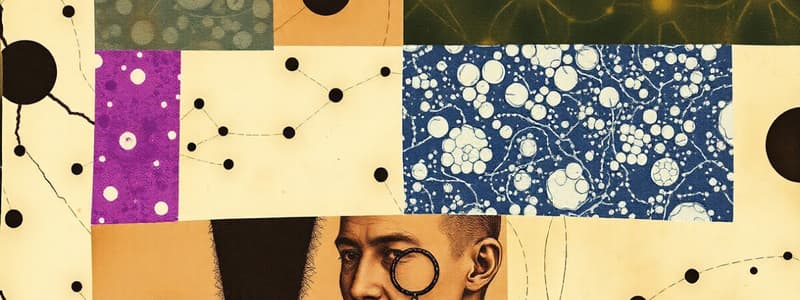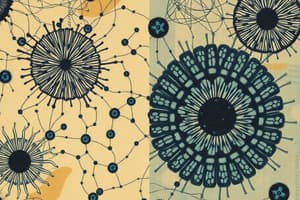Podcast
Questions and Answers
What is a distinguishing feature of plant cells that is not found in animal cells?
What is a distinguishing feature of plant cells that is not found in animal cells?
- Cilia
- Centrioles
- Lysosome
- Chloroplast (correct)
Which organelle is primarily involved in the synthesis of proteins?
Which organelle is primarily involved in the synthesis of proteins?
- Lysosomes
- Golgi apparatus
- Mitochondria
- Ribosomes (correct)
What type of microscopy is used to obtain clear images of the internal structures of organelles?
What type of microscopy is used to obtain clear images of the internal structures of organelles?
- Phase-contrast microscopy
- Optical microscopy
- Transmission electron microscopy (correct)
- Scanning electron microscopy
Which statement accurately describes the process of cell fractionation?
Which statement accurately describes the process of cell fractionation?
In what way does a large sap vacuole in plant cells contribute to their function?
In what way does a large sap vacuole in plant cells contribute to their function?
Which of the following components are found in both plant and animal cells?
Which of the following components are found in both plant and animal cells?
Which statement best explains the role of radioactive labeled amino acids in cellular studies?
Which statement best explains the role of radioactive labeled amino acids in cellular studies?
Which characteristic is true for animal cells but not for plant cells?
Which characteristic is true for animal cells but not for plant cells?
What is the primary function of the Golgi apparatus?
What is the primary function of the Golgi apparatus?
What is the primary function of mitochondria in cells?
What is the primary function of mitochondria in cells?
What process occurs in the Golgi apparatus to create glycoproteins?
What process occurs in the Golgi apparatus to create glycoproteins?
What structural feature distinguishes centrioles?
What structural feature distinguishes centrioles?
Which of the following accurately describes lysosomes?
Which of the following accurately describes lysosomes?
What is the role of the nuclear envelope?
What is the role of the nuclear envelope?
How are lysosomes synthesized and transported within a cell?
How are lysosomes synthesized and transported within a cell?
How does the number of mitochondria in a cell vary?
How does the number of mitochondria in a cell vary?
What structural adaptation of mitochondria aids in ATP production?
What structural adaptation of mitochondria aids in ATP production?
What is the endosymbiont theory primarily about?
What is the endosymbiont theory primarily about?
What is a characteristic of the 70S ribosomes found in mitochondria?
What is a characteristic of the 70S ribosomes found in mitochondria?
What is the appearance of the Golgi apparatus?
What is the appearance of the Golgi apparatus?
Which statement about the function of lysosomes is false?
Which statement about the function of lysosomes is false?
What role do centrioles play during nuclear division?
What role do centrioles play during nuclear division?
Which of the following statements is true about the nucleus?
Which of the following statements is true about the nucleus?
What is the significance of the intermembrane space in mitochondria?
What is the significance of the intermembrane space in mitochondria?
What is the main function of ribosomes that are free in the cytoplasm?
What is the main function of ribosomes that are free in the cytoplasm?
How do rough ER and smooth ER differ in structure?
How do rough ER and smooth ER differ in structure?
Which of the following organelles is involved in the synthesis of lipids?
Which of the following organelles is involved in the synthesis of lipids?
Which type of ribosome is found in prokaryotic cells?
Which type of ribosome is found in prokaryotic cells?
What is a characteristic of the lysosomes?
What is a characteristic of the lysosomes?
Which of the following statements is true about the Golgi apparatus?
Which of the following statements is true about the Golgi apparatus?
Where are ribosomes produced in a eukaryotic cell?
Where are ribosomes produced in a eukaryotic cell?
What is the primary role of the rough endoplasmic reticulum?
What is the primary role of the rough endoplasmic reticulum?
Flashcards
Scanning Electron Microscopy (SEM)
Scanning Electron Microscopy (SEM)
A type of microscopy that provides detailed images of intact organelles, ideal for measuring external dimensions and structures.
Transmission Electron Microscopy (TEM)
Transmission Electron Microscopy (TEM)
A type of microscopy that provides clear images of sections of the internal structures of organelles.
Cell Fractionation
Cell Fractionation
The process of separating cell structures based on their density using a centrifuge.
Radioactive Labeling
Radioactive Labeling
Signup and view all the flashcards
Mitochondria
Mitochondria
Signup and view all the flashcards
Chloroplast
Chloroplast
Signup and view all the flashcards
Golgi Apparatus
Golgi Apparatus
Signup and view all the flashcards
Lysosome
Lysosome
Signup and view all the flashcards
Endoplasmic Reticulum (ER)
Endoplasmic Reticulum (ER)
Signup and view all the flashcards
Rough ER
Rough ER
Signup and view all the flashcards
Smooth ER
Smooth ER
Signup and view all the flashcards
Ribosomes
Ribosomes
Signup and view all the flashcards
Vacuole
Vacuole
Signup and view all the flashcards
What is the Golgi apparatus?
What is the Golgi apparatus?
Signup and view all the flashcards
What is the role of the Golgi apparatus in protein modification?
What is the role of the Golgi apparatus in protein modification?
Signup and view all the flashcards
How does the Golgi apparatus package proteins and lipids?
How does the Golgi apparatus package proteins and lipids?
Signup and view all the flashcards
What are lysosomes?
What are lysosomes?
Signup and view all the flashcards
What is the function of lysosomes?
What is the function of lysosomes?
Signup and view all the flashcards
What are mitochondria?
What are mitochondria?
Signup and view all the flashcards
What is the function of the cristae in mitochondria?
What is the function of the cristae in mitochondria?
Signup and view all the flashcards
What is the role of mitochondria in cellular respiration?
What is the role of mitochondria in cellular respiration?
Signup and view all the flashcards
What is the main function of mitochondria?
What is the main function of mitochondria?
Signup and view all the flashcards
Why do some cells have more mitochondria than others?
Why do some cells have more mitochondria than others?
Signup and view all the flashcards
What are some uses for ATP produced by mitochondria?
What are some uses for ATP produced by mitochondria?
Signup and view all the flashcards
What are centrioles and what is their function?
What are centrioles and what is their function?
Signup and view all the flashcards
What is a centrosome and where is it located?
What is a centrosome and where is it located?
Signup and view all the flashcards
Describe the structure and function of the nucleus.
Describe the structure and function of the nucleus.
Signup and view all the flashcards
What is the relationship between the nuclear envelope and the endoplasmic reticulum?
What is the relationship between the nuclear envelope and the endoplasmic reticulum?
Signup and view all the flashcards
What is the endosymbiont theory?
What is the endosymbiont theory?
Signup and view all the flashcards
Study Notes
Plant Cell vs. Animal Cell
- Plant cells are larger (up to 40 µm) and have a regular shape, while animal cells are smaller (20 µm) and irregular.
- Plant cells have a cell wall, chloroplasts (with starch grains), and large central vacuoles. Animal cells have centrioles, lysosomes, and glycogen granules/cilia.
- Plant cells do not have centrioles; animal cells do.
Electron Microscopy
- Different types of electron microscopy provide varying information.
- Scanning electron microscopy (SEM) shows the outer dimensions of intact organelles.
- Transmission electron microscopy (TEM) shows sections of internal structures of organelles.
- Combining both methods creates a detailed image of cell ultrastructure.
Cell Fractionation
- Centrifugation, where faster rotation separates smaller particles by density.
- Larger structures sink further down the tube in a centrifuge.
- Radioactive-labelled substances help track specific cell components.
Cell Organelles (Membranous)
- Organelles are grouped into membranous and non-membranous.
- Membranous organelles have membranes separating their contents from the cytoplasm.
- Examples include: large vacuoles, endoplasmic reticulum (ER), Golgi apparatus, lysosomes, and secretory vesicles.
Cell Organelles (Non-Membranous)
- Organelles without membranes include ribosomes, starch grains, glycogen granules, cilia, centrosomes, and flagella.
Endoplasmic Reticulum (ER)
- The ER is an interconnected membrane system.
- Rough ER has ribosomes attached, involved in protein synthesis and modification. Proteins are folded and transported.
- Smooth ER synthesizes lipids, including cholesterol and steroid hormones, and other lipids like fatty acids.
Ribosomes
- Ribosomes are non-membranous organelles in all cells.
- Ribosomes for protein synthesis are either free in the cytoplasm (for intracellular use) or bound to the rough ER (for secretion).
- Ribosomes are two subunits (large and small).
- There are two types:
- 70S type: Found in prokaryotes, mitochondria, and chloroplasts.
- 80S type: Found in eukaryotes, free in the cytoplasm,or bound to the rough ER
Golgi Apparatus
- The Golgi apparatus modifies proteins and lipids, packages them into vesicles, and transports them to other parts of the cell or outside.
- Glycoproteins and glycolipids are formed during modification in the Golgi apparatus.
Lysosomes
- Lysosomes are spherical vesicles containing digestive enzymes.
- They break down excess or worn-out cellular components, food particles, and engulfed pathogens.
- Enzymes are synthesised in the rough ER, processed in the Golgi apparatus, and packaged into lysosomes.
Mitochondria
- Mitochondria are double-membrane-bound organelles.
- They have an outer membrane and an inner membrane folded into cristae.
- They are the site of aerobic respiration, producing ATP for cellular energy.
- Mitochondria are smaller and have circular DNA, ribosomes, and protein synthesis.
Centrosomes and Centrioles
- Centrosomes are an area near the nucleus containing two centrioles arranged at right angles.
- Centrioles organize microtubules during cell division and are only found in animal cells.
Nucleus
- The nucleus is a double membrane bound organelle, typically spherical in shape.
- The nuclear envelope surrounds the nucleus and regulates the passage of materials.
- It contains the cell's genetic material (DNA) and the nucleolus, a site for ribosome synthesis.
Endosymbiotic Theory
- Mitochondria and chloroplasts are believed to have originated from free-living prokaryotic organisms engulfed by eukaryotic cells.
- Evidence includes their own 70S ribosomes and circular DNA.
Studying That Suits You
Use AI to generate personalized quizzes and flashcards to suit your learning preferences.




